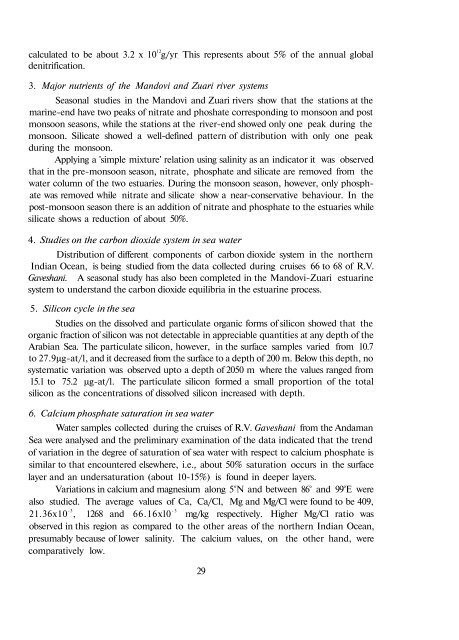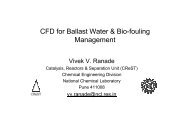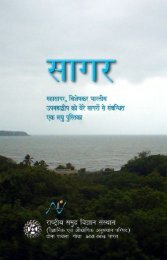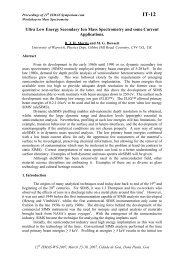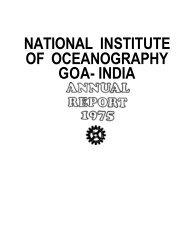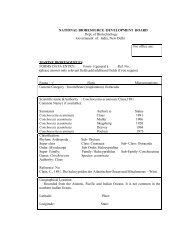1980 - National Institute of Oceanography
1980 - National Institute of Oceanography
1980 - National Institute of Oceanography
Create successful ePaper yourself
Turn your PDF publications into a flip-book with our unique Google optimized e-Paper software.
calculated to be about 3.2 x 10 12 g/yr · This represents about 5% <strong>of</strong> the annual global<br />
denitrification.<br />
3. Major nutrients <strong>of</strong> the Mandovi and Zuari river systems<br />
Seasonal studies in the Mandovi and Zuari rivers show that the stations at the<br />
marine-end have two peaks <strong>of</strong> nitrate and phoshate corresponding to monsoon and post<br />
monsoon seasons, while the stations at the river-end showed only one peak during the<br />
monsoon. Silicate showed a well-defined pattern <strong>of</strong> distribution with only one peak<br />
during the monsoon.<br />
Applying a 'simple mixture' relation using salinity as an indicator it was observed<br />
that in the pre-monsoon season, nitrate, phosphate and silicate are removed from the<br />
water column <strong>of</strong> the two estuaries. During the monsoon season, however, only phosphate<br />
was removed while nitrate and silicate show a near-conservative behaviour. In the<br />
post-monsoon season there is an addition <strong>of</strong> nitrate and phosphate to the estuaries while<br />
silicate shows a reduction <strong>of</strong> about 50%.<br />
4. Studies on the carbon dioxide system in sea water<br />
Distribution <strong>of</strong> different components <strong>of</strong> carbon dioxide system in the northern<br />
Indian Ocean, is being studied from the data collected during cruises 66 to 68 <strong>of</strong> R.V.<br />
Gaveshani. A seasonal study has also been completed in the Mandovi-Zuari estuarine<br />
system to understand the carbon dioxide equilibria in the estuarine process.<br />
5. Silicon cycle in the sea<br />
Studies on the dissolved and particulate organic forms <strong>of</strong> silicon showed that the<br />
organic fraction <strong>of</strong> silicon was not detectable in appreciable quantities at any depth <strong>of</strong> the<br />
Arabian Sea. The particulate silicon, however, in the surface samples varied from 10.7<br />
to 27.9μg-at/l, and it decreased from the surface to a depth <strong>of</strong> 200 m. Below this depth, no<br />
systematic variation was observed upto a depth <strong>of</strong> 2050 m where the values ranged from<br />
15.1 to 75.2 μg-at/l. The particulate silicon formed a small proportion <strong>of</strong> the total<br />
silicon as the concentrations <strong>of</strong> dissolved silicon increased with depth.<br />
6. Calcium phosphate saturation in sea water<br />
Water samples collected during the cruises <strong>of</strong> R.V. Gaveshani from the Andaman<br />
Sea were analysed and the preliminary examination <strong>of</strong> the data indicated that the trend<br />
<strong>of</strong> variation in the degree <strong>of</strong> saturation <strong>of</strong> sea water with respect to calcium phosphate is<br />
similar to that encountered elsewhere, i.e., about 50% saturation occurs in the surface<br />
layer and an undersaturation (about 10-15%) is found in deeper layers.<br />
Variations in calcium and magnesium along 5°N and between 86° and 99°E were<br />
also studied. The average values <strong>of</strong> Ca, Ca/Cl, Mg and Mg/Cl were found to be 409,<br />
21.36x10 -3<br />
, 1268 and 66.16xl0 -3<br />
mg/kg respectively. Higher Mg/Cl ratio was<br />
observed in this region as compared to the other areas <strong>of</strong> the northern Indian Ocean,<br />
presumably because <strong>of</strong> lower salinity. The calcium values, on the other hand, were<br />
comparatively low.<br />
29


